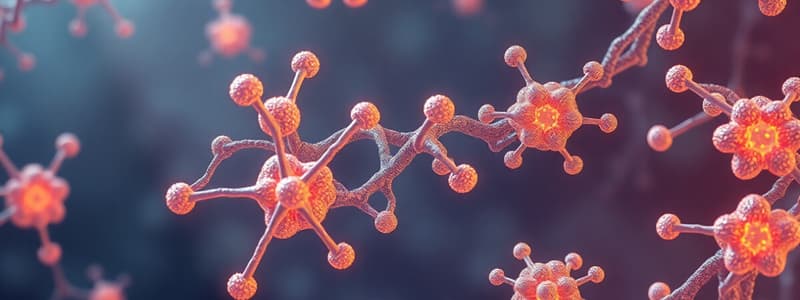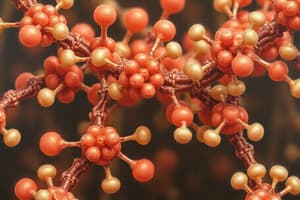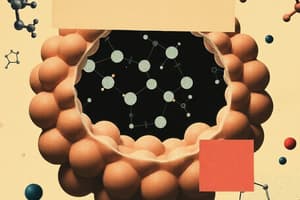Podcast
Questions and Answers
What is the smallest structural and functional unit of life?
What is the smallest structural and functional unit of life?
- Nucleotide
- Organelle
- Cell (correct)
- Macromolecule
Which of the following is NOT a type of monomer mentioned in the content?
Which of the following is NOT a type of monomer mentioned in the content?
- Nucleotide
- Fatty acid
- Monosaccharide
- Amino acid (correct)
What role do organelles play within a cell?
What role do organelles play within a cell?
- They work together to help the cell function. (correct)
- They are composed solely of lipids.
- They act as independent life forms.
- They are the basic building blocks of life.
Which of the following macromolecules is composed of monosaccharides?
Which of the following macromolecules is composed of monosaccharides?
What is the primary function of a nucleotide in biological systems?
What is the primary function of a nucleotide in biological systems?
What defines the active site of an enzyme?
What defines the active site of an enzyme?
What is the primary function of enzymes in biochemical reactions?
What is the primary function of enzymes in biochemical reactions?
What occurs during the differentiation of stem cells?
What occurs during the differentiation of stem cells?
Which statement about catalysts is true?
Which statement about catalysts is true?
Which of the following best describes amino acids?
Which of the following best describes amino acids?
Which characteristic describes the ability of living things to change and evolve over time?
Which characteristic describes the ability of living things to change and evolve over time?
Which of the following accurately describes a fundamental aspect of all living organisms?
Which of the following accurately describes a fundamental aspect of all living organisms?
What primary function do ribosomes serve within a cell?
What primary function do ribosomes serve within a cell?
What is the main role of the Golgi apparatus in cellular function?
What is the main role of the Golgi apparatus in cellular function?
Which organelle is responsible for cellular respiration?
Which organelle is responsible for cellular respiration?
What function do centrioles primarily serve during cell division?
What function do centrioles primarily serve during cell division?
Which of the following accurately describes the role of the cell membrane?
Which of the following accurately describes the role of the cell membrane?
What component of the cell membrane is primarily responsible for its selective permeability?
What component of the cell membrane is primarily responsible for its selective permeability?
Which type of molecules can pass easily through the cell membrane without assistance?
Which type of molecules can pass easily through the cell membrane without assistance?
How do carbohydrates contribute to the functionality of the cell membrane?
How do carbohydrates contribute to the functionality of the cell membrane?
What role do vesicles play in the transport of larger molecules across the cell membrane?
What role do vesicles play in the transport of larger molecules across the cell membrane?
What is the primary role of carbohydrates in biological systems?
What is the primary role of carbohydrates in biological systems?
What is a key function of lipids within the cell?
What is a key function of lipids within the cell?
Which statement best describes the function of nucleic acids?
Which statement best describes the function of nucleic acids?
Which of the following correctly describes the role of proteins in the cell?
Which of the following correctly describes the role of proteins in the cell?
What distinguishes proteins from other macromolecules?
What distinguishes proteins from other macromolecules?
Which of the following phases is NOT part of mitosis?
Which of the following phases is NOT part of mitosis?
How are a structure's components related to its function in the body?
How are a structure's components related to its function in the body?
What is the primary process that ensures identical genetic material in daughter cells?
What is the primary process that ensures identical genetic material in daughter cells?
Study Notes
Cell
- Fundamental unit of life, essential for all biological processes.
- Represents the smallest component that can perform life functions independently.
Organelle
- Specialized structures located within cells.
- Each organelle has distinct roles that contribute to the overall functionality of the cell.
Macromolecule
- Large biological molecules that form the building blocks of living organisms.
- Includes proteins, carbohydrates, nucleic acids, and lipids, all vital for cellular processes.
Nucleotide
- Basic structural unit of nucleic acids, such as DNA and RNA.
- Composed of a sugar, phosphate group, and nitrogenous base, playing a critical role in genetic information storage and transfer.
Fatty Acid
- Building block of lipids, which are essential components of cell membranes.
- Fatty acids can be saturated or unsaturated, influencing the properties of fats and oils.
Monosaccharide
- Simplest form of carbohydrates, consisting of single sugar molecules.
- Key sources of energy for cells, with examples including glucose and fructose.
Amino Acids
- Serve as the building blocks of proteins, essential for various biological functions.
- Each amino acid has a specific structure that contributes to the overall protein conformation.
Enzymes
- Act as biological catalysts, increasing the rate of biochemical reactions.
- Primarily composed of proteins, although some catalytic RNA molecules (ribozymes) exist.
Catalysts
- Speed up reactions by lowering the activation energy required for the reaction to proceed.
- Remain unchanged after the reaction and do not alter the reactants or products.
Active Site
- A unique region on an enzyme designed for substrate binding, determining enzyme specificity.
- The shape and chemical environment of the active site play a crucial role in the catalytic process.
Differentiation
- Refers to the process where stem cells transform into specialized cells with distinct functions.
- Essential for development, tissue repair, and maintaining homeostasis within an organism.
Fundamental Characteristics of Living Things
- Cellular Composition: All living organisms are made up of one or more cells, which are the basic units of life.
- Response to Stimuli: Living things can detect and respond to changes in their environment, showcasing awareness and interaction.
- Growth and Reproduction: Organisms have the capability to grow and reproduce, ensuring the continuation of their species through various reproductive methods.
- Metabolism: Living organisms utilize energy through metabolic processes, enabling them to perform essential functions like metabolism, digestion, and cellular repair.
- Genetic Material: All living things contain DNA or RNA, which carry the genetic information necessary for the growth, functioning, and reproduction of the organism.
- Adaptation: Organisms can adapt to their environments over time, promoting survival in changing conditions and contributing to the evolutionary process.
Organelles and Their Functions
-
Cell Membrane: Regulates the influx and efflux of substances, maintaining homeostasis within the cell.
-
Centrioles: Essential for cell division; facilitate the organization of spindle fibers to ensure accurate chromosome separation.
-
Cilia: Hair-like structures that propel fluid and particles across the cell surface, aiding in movement and clearance.
-
Flagella: Long, whip-like structures enabling cellular movement through surrounding fluids, essential for sperm motility.
-
Nucleus: Command center of the cell; contains genetic material (DNA) that dictates cellular functions and replication processes.
-
Ribosomes: Molecular machines responsible for synthesizing proteins by translating messenger RNA (mRNA).
-
Rough Endoplasmic Reticulum (Rough ER): Studded with ribosomes; primarily involved in protein synthesis and initial folding modifications.
-
Smooth Endoplasmic Reticulum (Smooth ER): Lacks ribosomes; functions in lipid synthesis, chemical modifications, and calcium ion storage for muscle contraction.
-
Golgi Apparatus: Modifies, sorts, and packages proteins for secretion or delivery to other organelles, crucial for cellular communication.
-
Vesicles: Membrane-bound transport units that ferry proteins and other molecules to their designated locations within or outside the cell.
-
Lysosomes: Digestive organelles containing enzymes to break down waste materials and cellular debris, essential for maintaining cellular health.
-
Vacuoles: Storage compartments for nutrients, waste, and other substances, helping to maintain osmotic balance and storage needs.
-
Mitochondria: Powerhouses of the cell where cellular respiration occurs, converting nutrients into ATP (adenosine triphosphate) for energy.
Structure of the Cell Membrane
- Composed of two layers of phospholipids, creating a bilayer that forms the core structure.
- Hydrophilic (polar) heads face outward towards the aqueous environment, promoting interaction with water.
- Hydrophobic (nonpolar) tails face inward, away from water, contributing to membrane stability and integrity.
Components of the Cell Membrane
- Carbohydrates are embedded in the membrane, playing critical roles in structural support and cell signaling processes.
- Proteins are integrated within the membrane, functioning as channels for transporting substances and engaging in signaling pathways.
Selective Permeability
- The membrane's structure grants selective permeability, allowing the regulation of substances entering and exiting the cell.
- Small, nonpolar, hydrophobic, and neutral molecules can easily pass through the lipid bilayer.
- Water, though polar, can still cross the membrane due to its small size.
- Polar molecules require protein channels for transport, as they cannot diffuse freely through the lipid bilayer.
- Large molecules utilize vesicles for transport, facilitating their movement across the membrane.
Carbohydrates
- Serve as energy storage molecules, providing fuel for cellular processes.
- Play a crucial role in structural uses and are key for recognition within signal transduction pathways, enabling communication between cells.
Lipids
- Act as energy storage molecules, harboring reserves for metabolic needs.
- Form the primary structure of cell membranes, contributing to fluidity and barrier functions.
- Provide protection and insulation to organs, helping to maintain body temperature.
Nucleic Acids
- Function as informational molecules, essential for the storage, transmission, and expression of genetic information.
- Serve as a blueprint for protein synthesis, guiding the assembly of amino acids into functional proteins.
Proteins
- Encompass a wide range of functions including enzymatic activity, signaling, and serving as receptors.
- Play key structural roles in cells and tissues, supporting cellular architecture.
- Involved in regulatory processes, muscle contractions, and immune responses to protect against disease.
- Facilitate transport and storage of various molecules within organisms.
Cell Structure and Organization
- Organization of life: Organisms consist of organ systems, which are made up of organs, tissues, and the most basic unit, cells.
Cell Cycle
- Interphase is the longest phase of a cell's life, where essential processes occur before division.
- S phase (Synthesis phase) is critical during interphase, as DNA is replicated, ensuring daughter cells receive identical chromosomes to the parent cell.
Mitosis Process
- Mitosis consists of four key stages:
- Prophase: Chromosomes condense and become visible; the nuclear envelope begins to break down.
- Metaphase: Chromosomes align along the cell's equatorial plane for separation.
- Anaphase: Sister chromatids are pulled apart toward opposite poles of the cell.
- Telophase: Chromatids reach the poles, and nuclear envelopes reform around each set of chromosomes.
Cytokinesis
- Cytokinesis follows mitosis, resulting in the division of the cytoplasm into two identical daughter cells.
Structure-Function Relationship
- The structure of cells, organs, and organ systems is inherently linked to their function.
- Understanding the anatomy of biological structures helps in deducing their roles in overall physiological processes.
Studying That Suits You
Use AI to generate personalized quizzes and flashcards to suit your learning preferences.
Description
Test your knowledge on the fundamental concepts of biology, including the definitions and functions of cells, organelles, macromolecules, and their monomers. This quiz will challenge your understanding of the basic building blocks of life.



